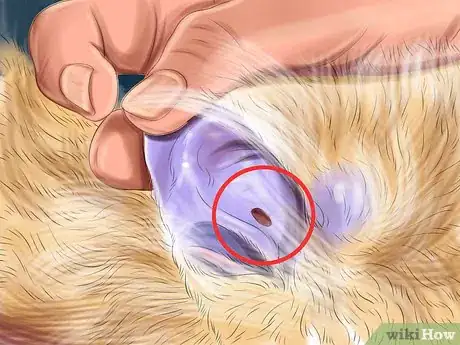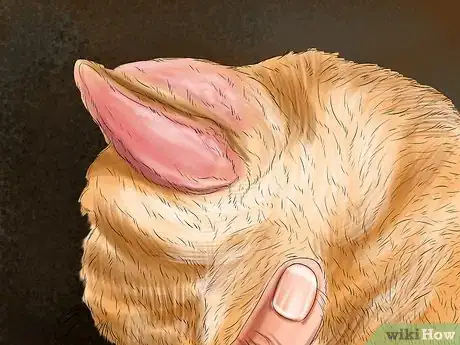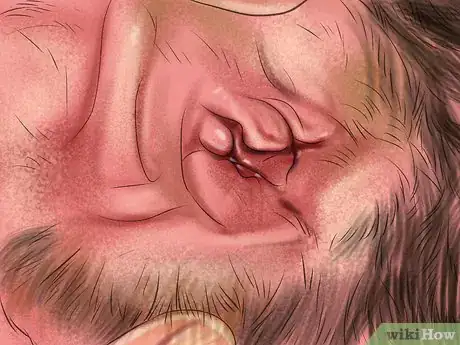This article was co-authored by Pippa Elliott, MRCVS. Dr. Elliott, BVMS, MRCVS is a veterinarian with over 30 years of experience in veterinary surgery and companion animal practice. She graduated from the University of Glasgow in 1987 with a degree in veterinary medicine and surgery. She has worked at the same animal clinic in her hometown for over 20 years.
This article has been viewed 20,278 times.
Cats can develop a variety of different ear problems. Some of these problems may be minor, but some are serious. Being able to spot early signs of ear problems can help you catch a problem before it turns into something major. To look for ear problems, look for any changes to the ear, notice any signs of pus or foul smells, and watch to see if your cat scratches their ear, tilts their head, or has trouble walking.
Steps
Noticing External Ear Problems
-
1Check for signs of a fight. If your cat gets into a fight, this may lead to ear injuries. Gently look inside your cat’s ear to check for any signs of a bite or scratch. If there is a scratch wound from a claw, it will be long and thin. Bite marks may look like tiny punctures or a scrape.[1]
- If your cat has shallow bite or scratch marks, you probably can just let it heal. Make sure to watch it for infection.
-
2Notice signs of infection. If your cat has gotten into a fight or somehow gotten a wound in their ear, make sure to monitor it for signs of infection. Some wounds heal without any problems. However, some bite or scratch marks can get infected. Signs of infection may include colored or cloudy pus around the wound and foul odors. It may also be hot to the touch.[2]
- Look for swelling of the tissue inside or outside the ear. These are signs of infection.
- Abscesses with pus can develop in ear wounds.
Advertisement -
3Check for a hematoma. Though rare, cats may develop a hematoma. This is a swollen place on the ear that is filled with blood. It occurs when a blood vessel bursts under the skin. This generally occurs from some sort of shaking or scratching by the cat.[3]
- The cat will have a swollen, red place in their ear.
- It is painful, so the cat’s ear may be sensitive to touch.
-
4Look at the tips of the ears. Solar dermatitis is a condition that causes swelling of the ear tips. This is caused by excessive exposure to sunlight and UV rays. This is more common is light or pale colored cats with light colored ears. This also can happen more readily in areas with higher levels of UV sunlight.[4]
- Look for skin that is pink and scaly. If it advances, the skin may be crusted, develop sores, or start to bleed.
- If left untreated, this can turn into skin cancer.
-
5Monitor for signs of mites. Mites can infect your cat’s ears. This can cause irritation and redness. The ears may be sensitive to touch or swollen. You may find that your cat is scratching their ears more or shaking their head a lot.[5]
- Often, you can see mites in the cat’s ear. They may be white, orange, or darker dots. You may also notice the specks moving around.
Recognizing Internal Ear Problems
-
1Check for ear canal mite infections. An ear mite infection can occur in the ear canal, which can be painful for your cat and cause problems.. You can see a white buildup around the ear canal or right inside the ear canal. The buildup is made up of mites, so it may look like it’s moving.[6]
- The most obvious sign of an ear mite infection is head shaking or itching.
- Depending on the severity of the infection, there may be a dark discharge from the ear canal.
- Ear mites may also lead to bacterial infections.
-
2Look for bacterial infections. Ears can develop bacterial infections, often in conjunction with other ear problems. If your cat has a bacterial infection in their ear, you will see pus in the ear. Generally the ear has a bad smell. You cat may also favor the ear or be sensitive to touch.[7]
- Bacterial infections may also occur with fungal infections.
-
3Monitor for nodules on the ear. Cats can get ear tumors, especially once they are seniors. The tumors occur along the skin lining. They can look like nodules on the ear. They are usually accompanied by an infection.[8]
- The tumors may be benign or malignant.
-
4Watch for signs of inner and middle ear problems. When your cat develops problems in their inner and middle ear, there may not be any symptoms on their ear. Instead, their behavior may be affected.[9]
- Your cat may walk oddly due to balance problems. They may fall down or trip.
- The cat may hold their head to one side as they walk. Your cat may also walk around in circles.
Seeking Medical Help
-
1Take your cat to the vet. If you notice any problems with your cat’s ear, you should take them to the vet. Don't wait to see what happens. Ear problems may develop into something worse if left untreated. However, most ear problems are often not serious, especially with proper treatment. Your vet can examine your cat and discuss a proper course of treatment.[10]
- If it looks like the cat just has a surface scratch, you may not need to take them to the vet. Instead, monitor the ear to look for any signs of infection.
-
2Determine the underlying cause. After the veterinarian examines your cat’s ear, they may do a physical examination to determine any underlying causes of the ear condition. Some conditions, like hematomas, have underlying conditions that lead to the ear problem.[11]
- Underlying problems may include a hematoma, a respiratory infection, or other infections.
- Make sure to tell your vet all important information about your cat. This may include if they have been in a fight or around other cats, if they have changed their eating habits, or if they have any other symptoms.
-
3Decide on the appropriate treatment. Once your vet has determined the specific ear condition, they will come up with the appropriate treatment. This may be something simple, like antibiotics, antifungals, or other medication if it is an infection or problem with ear mites.[12]
- For some conditions, like a tumor, the treatment may be serious, like surgery. But this is usually for rare cases.
Expert Q&A
-
QuestionHow do you know if your cat has an ear infection?
 Melissa Nelson, DVM, PhDDr. Nelson is a Veterinarian who specializes in Companion and Large Animal Medicine in Minnesota, where she has over 18 years of experience as a veterinarian in a rural clinic. She received her Doctor of Veterinary Medicine from the University of Minnesota in 1998.
Melissa Nelson, DVM, PhDDr. Nelson is a Veterinarian who specializes in Companion and Large Animal Medicine in Minnesota, where she has over 18 years of experience as a veterinarian in a rural clinic. She received her Doctor of Veterinary Medicine from the University of Minnesota in 1998.
Veterinarian The ear may smell or have a lot of discharge, or it may be red, itchy and painful for the cat.
The ear may smell or have a lot of discharge, or it may be red, itchy and painful for the cat. -
QuestionHow can you tell if your cat has ear mites?
 Melissa Nelson, DVM, PhDDr. Nelson is a Veterinarian who specializes in Companion and Large Animal Medicine in Minnesota, where she has over 18 years of experience as a veterinarian in a rural clinic. She received her Doctor of Veterinary Medicine from the University of Minnesota in 1998.
Melissa Nelson, DVM, PhDDr. Nelson is a Veterinarian who specializes in Companion and Large Animal Medicine in Minnesota, where she has over 18 years of experience as a veterinarian in a rural clinic. She received her Doctor of Veterinary Medicine from the University of Minnesota in 1998.
Veterinarian Ear mites make the ear itchy and generally the cat will have brown, crumbly discharge in the ear.
Ear mites make the ear itchy and generally the cat will have brown, crumbly discharge in the ear. -
QuestionCan an indoor cat have ear mites?
 Melissa Nelson, DVM, PhDDr. Nelson is a Veterinarian who specializes in Companion and Large Animal Medicine in Minnesota, where she has over 18 years of experience as a veterinarian in a rural clinic. She received her Doctor of Veterinary Medicine from the University of Minnesota in 1998.
Melissa Nelson, DVM, PhDDr. Nelson is a Veterinarian who specializes in Companion and Large Animal Medicine in Minnesota, where she has over 18 years of experience as a veterinarian in a rural clinic. She received her Doctor of Veterinary Medicine from the University of Minnesota in 1998.
Veterinarian Yes, an indoor cat can have ear mites because another cat or even a dog can spread the mites to the indoor cat.
Yes, an indoor cat can have ear mites because another cat or even a dog can spread the mites to the indoor cat.
References
- ↑ http://www.pethealthnetwork.com/cat-health/cat-diseases-conditions-a-z/ear-infections-cats
- ↑ http://www.pethealthnetwork.com/cat-health/cat-diseases-conditions-a-z/ear-infections-cats
- ↑ https://vcahospitals.com/know-your-pet/hematoma-of-the-ear-in-cats
- ↑ https://vcahospitals.com/know-your-pet/solar-dermatitis-in-cats
- ↑ https://www.vet.cornell.edu/departments-centers-and-institutes/cornell-feline-health-center/health-information/feline-health-topics/ear-mites-tiny-critters-can-pose-major-threat
- ↑ https://www.vet.cornell.edu/departments-centers-and-institutes/cornell-feline-health-center/health-information/feline-health-topics/ear-mites-tiny-critters-can-pose-major-threat
- ↑ https://icatcare.org/advice/ear-problems-in-cats/
- ↑ https://icatcare.org/advice/ear-problems-in-cats/
- ↑ http://www.petmd.com/cat/conditions/ears/c_ct_otitis_media_interna
About This Article
To check your cat's ears for problems, start by looking for scratches that could get infected or any white, orange, or darker moving specks that could be ear mites. You can also check for hematoma, or swollen spots from burst blood vessels, but those are typically rare in cats. Look even deeper by checking your cat's ear canal for dark discharge from an ear mite infection or pus from a bacterial infection. If you notice problems with your cat's ear, take it to the vet immediately, as ear problems can become worse without treatment. For more tips from our Veterinary co-author, like how to tell if your cat has solar dermatitis from too much sun, keep scrolling.









































































Medical Disclaimer
The content of this article is not intended to be a substitute for professional medical advice, examination, diagnosis, or treatment. You should always contact your doctor or other qualified healthcare professional before starting, changing, or stopping any kind of health treatment.
Read More...